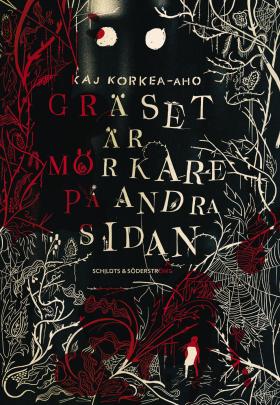
Gräset är mörkare på andra sidan
(The Grass is Darker on the Other Side)
by Kaj Korkea-aho
reviewed by Anna Paterson
The fact that the title’s grass is ‘darker’ turns a homely saying about covetousness into something more sinister. What ‘other side’, anyway? Lines that begin the book speak of an alien place where ‘all is darker … where the dragon dreams.’ As in the best fantasy novels, the possibility of unknowable forces on the very fringe of our perceivable reality lends depth and tension to Korkea-aho’s new novel.
The main storylines link four men in their thirties, childhood friends who meet again, in and around their home village. Knowing and urbanised, they are still marked by growing up in one of many scattered, isolated clusters of human dwellings set in the austere Finnish countryside, all lakes, forests and moorland. Simon, the doubting vicar, has returned to look after the local parish and Christoffer, the academic ethnologist, tries to adjust his new gay love-life to remembered feelings of guilt. Loke is a popular broadcaster who stutters badly outside the studio and whose disturbed speech is rooted in the childish dread that hit him in the wake of his mother’s fatal accident. The personalities of these three are compounds of reason and emotion but the fourth, Benjamin, is defined by emotions: initially grief-stricken after the death of Sofie, his partner and Loke’s sister, he regresses into an obsessive state as he looks for clues of betrayal – has she had an affair, maybe several? Later still, he becomes unhinged with rage, at terrible cost to himself and others, as he uncovers a ruinous flaw concealed beneath her bright personality.
Memories of Sofie are important to them all. Loved by Benjamin and Loke (as children, they loved a little too well), she was liked by all who knew her and widely admired for her kindness and punctiliousness. Sofie’s accident seems inexplicable – her car crashed into a tree along a familiar road in full daylight – but takes on another dimension when Benjamin receives a roadside camera snapshot that contains an intimation of pure evil. The passenger seat next to Sofie is occupied by a dark shape, so dense it seems to have ‘gulped down all available light, as if it were a gaping hole in reality’.
Benjamin immediately realises who it is, as do the others. The dark shape must be the Raamt and it follows that the attempts to find a normal cause of Sofie’s accident might as well end. They all know since childhood what Christoffer explains in his postgraduate thesis: When the Raamt, ‘a shadowy figure whose eyes suddenly gleam in the dark and make your hair stand on end’, is on the move outside the deep forest, it leaves a trail of failed crops, sickness and death. Its presence spooks even contemporary police investigations into abduction and murder.
But the Raamt does not always kill. By the end of the story, all four have survived its presence and felt pity mingling with their fear. The Raamt can charge the lowkey tragicomedy of people’s everyday lives with dramatic force. At the end of a final series of appearances, in which the shadow pursues but does not harm Loke’s friends (how can that be...?), their lives even improve.
Simon’s sighting initiates a chain of events full of black humour and misery that leads to his potential liberation from the service of God. Christoffer’s internal tensions are finally swept away as he turns his back on his uncomprehending parents and dull, back-woods brother to find security and fun in a lifetime union with a sexy actor. Loke, more traumatised by his childhood than the others, completes his transformation from an unhappy, stuttering boy into balanced man with a stutter. After a last crisis, even maddened Benjamin, victimised in a succession of ways, some terrible, others petty, seems on the road back to sanity.
The mystery of the Raamt drives this complex narrative and, at the same time, is its source of weakness. Like all sane people, the author can’t resist construing a rational, psychological explanation to the supernatural and using it to organise the many strands of his narrative. The intertwining stories, including Sofie’s, could work without fantasy underpinning. The Raamt may be nothing but a psychological miasma shared between people with childhood secrets and lore they have in common. The Raamt might even signify something like the obscure outcomes of our failures to understand each other. As Loke’s speech therapist, who is also a Sami witch, tells him at one point: ‘It is important to speak. To let the darkness out…’ By then, readers with a fondness for magic may feel that a promising otherworldly creature has disintegrated into a set of ‘communication issues”. But it is a silly concern, given that the whole of Korkea-aho’s second novel is a witty, enthralling and deeply thoughtful account of being young in a country where ancient Nordic mysteries still pervade what we recognise as of our own present.
A translated extract from the novel appears in the SBR special issue Cool Swedish Titles from Finland

Gräset är mörkare på andra sidan
Schildts & Söderströms, 2012. 426 pages.
